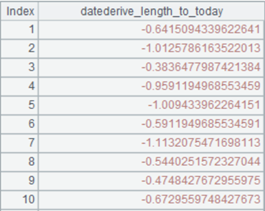datederive()
Here are how to use datederive() functions.
A.datederive()
Description:
Generate multiple derivative variables for a datetime sequence variable.
Syntax:
|
A.datederive(T) |
During modeling, generate multiple variables for datetime variable A for building models and return a binary sequence where the first bit is a table sequence made up of all the derivative variables and the second bit is generation process records Rec; the derivative variables automatically perform subsequent pre-processing |
|
A.datederive@r(Rec) |
During scoring, generate a table sequence consisting of multiple derivative variables used for model building according to datetime variable A and generation process records Rec |
Note:
External library function (See External Library Guide).
It generates multiple derivative variables for a datetime sequence variable A.
Parameter:
|
A |
A sequence of datetime variable values |
|
T |
The target variable value used to perform potential data smoothing |
|
Rec |
A sequence of generation process records |
Option:
|
@bnie |
Each option specifies a target type, and options are mutual-exclusive; automatically judge the type when no option is used; the order of priorities of the options is binary, numeric, integer and enumerated |
Return value:
Sequence/Table sequence
Example:
|
|
A |
|
|
1 |
=100.(date(2020,rand(11)+1,rand(28)+1)) |
Generate training data, which is a sequence of datetime variable values. |
|
2 |
=100.(date(2021,rand(11)+1,rand(28)+1)) |
Generate scoring data, which is a sequence of date variable values. |
|
3 |
=100.(rand(500)) |
Generate a target variable. |
|
4 |
=A1.datederive@i(A3) |
A4(1) A table sequence of derivative variables; A4(2) Generation process records Rec. @i specifies the target variable as integer. |
|
5 |
=A2.datederive@r(A4(2)) |
Generate derivative variables on the scoring data according to A4’s generation process records Rec. |
P.datederive()
Description:
The external library function (See External Library Guide) generates multiple derivative variables from a date table sequence/record sequence variable.
Syntax:
|
P.datederive(cn, T) |
During modeling, generate multiple variables for datetime variable cn for building models and return a binary sequence where the first bit is a table sequence made up of all the derivative variables and the second bit is generation process records Rec; the derivative variables automatically perform subsequent pre-processing |
|
P.datederive@r(cn, Rec) |
During scoring, generate a table sequence consisting of multiple derivative variables used for model building according to datetime variable cn and generation process records Rec |
Parameter:
|
P |
A table sequence/record sequence |
|
cn |
A string/number, which is the name of column (or the column number starting from 1) – the to-be-pre-processed variable – in a table sequence or record sequence |
|
T |
The target variable value used to perform potential data smoothing |
|
Rec |
A sequence of generation process records |
Option:
|
@bnie |
Each option specifies a target type, and options are mutual-exclusive; automatically judge the type when no option is used; the order of priorities of the options is binary, numeric, integer and enumerated |
Return value:
A sequence/table sequence
Example:
|
|
A |
|
|
1 |
=T("D: //catering_sale.csv").run(date1=date(date1,"yyyy/MM/dd")) |
|
|
2 |
=A1.datederive@i("date1","sales") |
Take “sales” as the target variable and generate multiple derivative variables for date variable “date1”: A2(1) A table sequence of derivative variables; A2(2) Generation process records Rec. @i specifies the target variable as integer. |
|
3 |
=A1.datederive@r("date1",A2(2)) |
Generate derivative variables for “date1” according to A2’s generation process records Rec, and return a table sequence of derivative variables. |



